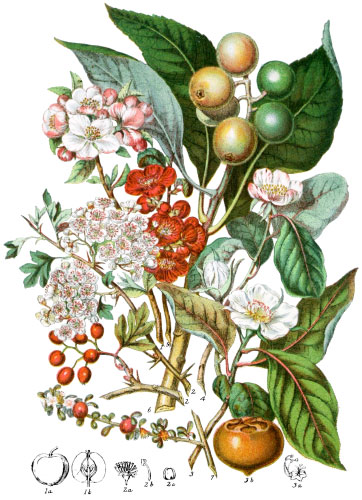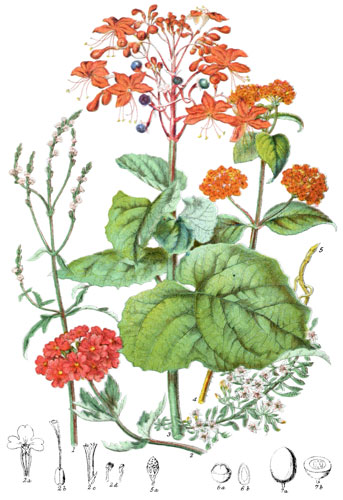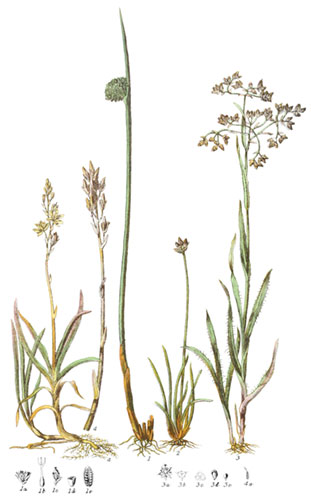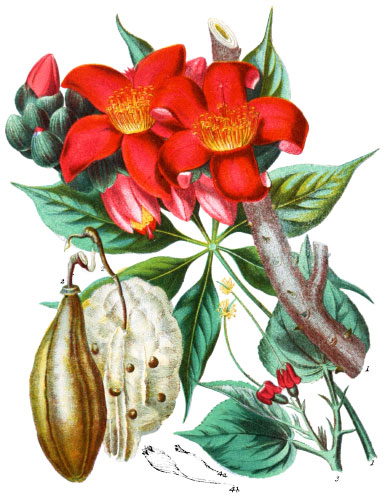Key characteristics
Soft herbaceous plants, and a very few shrubs; the leaves alternate, entire, or divided, with minute gland-like stipules; sometimes rough, with very small tubercles on the surface and at the edges. The flowers grow in racemes or spikes, the flower-stalks have small bracts at their base; the calyx is parted into four or six segments, which are not closed in the bud. The petals are four or six, alternate with the sepals, or absent; each petal has a broad fleshy plate at the base, with slender unequal fringes proceeding from the back, like the sepals not closed in the bud: those next the stem are larger than the rest, the lower petal sometimes altogether wanting. The pistil and stamens are placed at the edge of a large disk, spreading at the back, glandular on its surface; the stamens are from ten to twenty, the anthers two-celled, opening lengthwise. The stigmas are three, glandular, placed at the top of the three-lobed ovary. The seed-vessel is dry and membranous, or succulent in Ochradenus, opening at the top, usually having the seeds attached to three ridges: the seeds are kidney-shaped, pendulous, arranged in a double series or scattered, white or brown, without albumen; the covering crustaceous and dotted.
This Order has most affinity with the Caper tribe; there is also some resemblance to Polygalaceæ.
The only remarkable properties of these plants are the colouring matter of the Weld, and the fragrance of the Mignonette.
Reseda is said to have been so named by the romans from its supposed soothing properties in allaying pain.
Select plants in this order
Not all plants listed are illustrated and not all plants illustrated are listed.
- Reseda luteola (1) is very common in many parts of England, especially on a chalk soil, frequent in fallow fields, on walls, and on waste ground of various kinds; it is observed to be one of the first plants that spring up amongst the rubbish cast out of coal-pits. It grows to the height of two or three feet, in slender branches, nearly upright; but Linnæus remarked that they incline towards the sun throughout the day, bending northwards by night. The flowers have scarcely any scent, and the plant when bruised is disagreeable; the seed-vessel is of a rounder shape than that of other species, and on a shorter stalk. The whole plant yields a fine yellow dye—obtained by boiling whilst in flower. It serves for wool, cotton, or silk, either as pure yellow, or mixed with indigo for green; in France this is much used—large bales of Gaude may be seen on the quay at Caen in summer or autumn.
- R. lutea (2) is also an inhabitant of chalk soil, abundant in the Isle of Thanet and other similar districts. The spike of flowers very nearly resembles that of R. ordorata (3), but is very slightly scented; the sepals and petals are six; the narrow curled leaves are often brought through France, with its French name Mignonette, to England, about a century ago. No other plant was every so rapidly dispersed, or acquired such general favour, without utility, but merely for the delightful odoriferous scent of its flowers, which is of extreme subtilty, and conveyed by the air to some distance. With continual clipping the plant may be rendered a perennial, and even shrubby. In France, where it is cultivated to a great extent, the Parisians are remarkably fond of it, and until late in autumn the gardens of the Tuileries are perfumed with its delicious fragrance.
- R. phyteuma is an esculent herb in the Greek Archipelago.
- R. scoparia is a species growing on the Peak of Teneriffe.
- R. dipetala belongs to the Cape of Good Hope. One species, with a dense spike of white flowers, has been found in Affghanistan, and soe malso are said to have been seen in the southern provinces of Canton.
- Caylusea is a genus growing in Brazil, discovered by Auguste de S. Hiaire, at present unknown in English gardens.
Locations
Europe is the chief station of this Tribe; some species extend into the islands of the Mediterranean, and the neighbouring countries of Asia; a very few have been discovered in the north of India, the Cape of Good Hope, and California.
Legend
- Reseda luteola, Dyers’-weed, or Weld. England.
- Flower, front.
- Flower, side.
- Seed-vessel, opened.
- Reseda lutea, Wild Mignonette. England.
- Flower, front.
- Flower, back.
- Upper Petal.
- Side Petal.
- Disk with Stamens and Pistil.
- Stamens.
- Pistil.
- Section of Seed-vessel.
- Seed.
- Reseda odorata, Mignonette. Egypt.
- Flower, magnified.
- Upper Petal.
- Side Petal.
- Seed-vessel, opened.
- Seed.
Explore more
Posters
Decorate your walls with colorful detailed posters based on Elizabeth Twining’s beautiful two-volume set from 1868.
Puzzles
Challenge yourself or someone else to assemble a puzzle of all 160 botanical illustrations.





